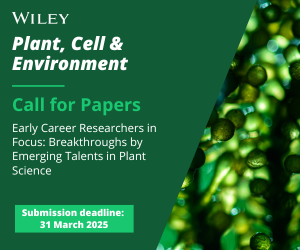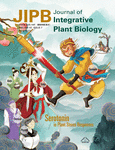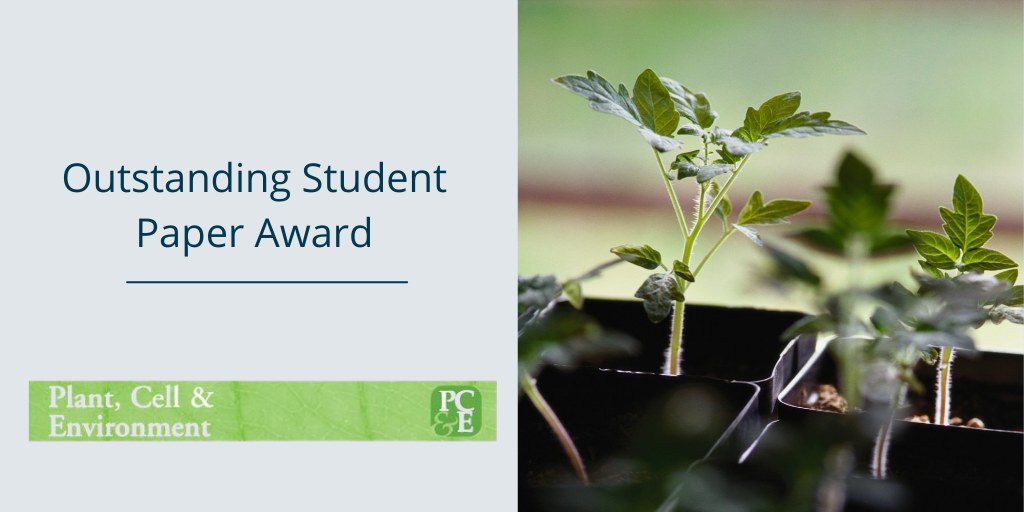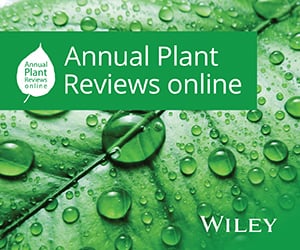Journal list menu
Export Citations
Download PDFs
Table of Contents
Role of melatonin in UV-B signaling pathway and UV-B stress resistance in Arabidopsis thaliana
- First Published: 29 August 2020
Several studies have demonstrated that melatonin plays a role in UV-B responses, however, the molecular mechanism whereby melatonin affects the UV-B pathway was not clear. This study examined the function of melatonin in molecular signaling pathways, physiological changes, and UV-B stress resistance under UV-B radiation in Arabidopsis. Exogenous melatonin treatment experiment indicated that melatonin could enhance the transcriptional level of genes on UV-B signaling pathway and ameliorate ROS damage caused by UV-B stress. This result was verified in SNAT overexpressing lines and knock-down mutant.
CAM-physiology and carbon gain of the orchid Phalaenopsis in response to light intensity, light integral and CO2
- First Published: 27 November 2020
In CAM-species Phalaenopsis the malate decarboxylation rate responded to light intensity, but in the long term it was the light integral during phase III that regulated the malate pool. Elevated CO2 enhanced diel carbon gain, both in CAM-phase IV and I, proving that neither storage capacity, nor substrate (PEP) were limiting factors.
UV-B signalling in rice: Response identification, gene expression profiling and mutant isolation
- First Published: 29 December 2020
Rice responds to UV-B, as seen in coleoptile growth inhibition, much more sensitively than Arabidopsis and with UV-B-regulated genes largely different from Arabidopsis ones. UV-B response mutants can be isolated from purple rice. Rice will serve as a new model plant for UV-B signalling studies.
Different response modes and cooperation modulations of blue-light receptors in photomorphogenesis
- First Published: 04 March 2021
We built a theoretical model to provide explanation and prediction about different responses and cooperation mechanisms of CRY1 and CRY2, including fast phosphorylation and degradation of CRY2, domination of BIC in CRY2-signalling, mediation of CRY1 in CRY2 phosphorylation and domination of CRY1 in photomorphogenesis.
Long-term adaptation of Arabidopsis thaliana to far-red light
- First Published: 18 February 2021
The photosynthetic apparatus of plants can undergo massive changes. Arabidopsis plants acclimate to far-red light by changing the photosystems ratio and their antenna sizes. These changes are not due to dark-induced senescence but are triggered by the redox state of the electron carriers.
A poplar B-box protein PtrBBX23 modulates the accumulation of anthocyanins and proanthocyanidins in response to high light
- First Published: 10 June 2021
The BBX transcription factors PtrBBX23 promote anthocyanins and proanthocyanidins accumulation by directly regulating the expression of MYB transcription factors and structural genes in the flavonoid pathway in response to high light.
Long-term abscisic acid promotes golden2-like1 degradation through constitutive photomorphogenic 1 in a light intensity-dependent manner to suppress chloroplast development
- First Published: 15 June 2021
Here, we show that long-term ABA promotes GLK1 degradation through COP1 to suppress chloroplast development dependent on light intensity, revealing that balancing normal growth and stress response in long-term stress.
Cryptochromes are the dominant photoreceptors mediating heliotropic responses of Arabidopsis inflorescences
- First Published: 28 June 2021
We investigated the phototropic response of A. thaliana inflorescences in the laboratory and in the field. Under natural conditions, plants displayed heliotropic inflorescences. The heliotropic response under full sunlight was activated by UV-A/blue light photons, acting through the cryptochromes.
Pest and disease management by red light: Pest and disease management by red light
- First Published: 30 June 2021
This work provides comprehensive knowledge of red light connected signalling under different biotic stressors. Effects of red light discussed from the aspect of both plants and pathogens.
Functional comparison of the WD-repeat domains of SPA1 and COP1 in suppression of photomorphogenesis
- First Published: 12 July 2021
We conducted a domain swap approach exchanging the WD-repeat domains of SPA1 and COP1 proteins in the Arabidopsis COP1/SPA ubiquitin ligase. We demonstrate that SPA1-WD can functionally replace the WD-repeat domain in COP1, while COP1-WD has no activity in the context of the SPA1 protein.
Red and blue light treatments of ripening bilberry fruits reveal differences in signalling through abscisic acid-regulated anthocyanin biosynthesis
- First Published: 01 August 2021
Both red and blue light promoted anthocyanin biosynthesis in non-climacteric bilberry fruit, regulated by abscisic acid metabolism. The key difference was detected in genes involved in abscisic acid (ABA) metabolism and signalling. Red light induced high accumulation of delphinidins towards end of berry ripening.
Plastic response to early shade avoidance cues has season-long effect on Beta vulgaris growth and development
- First Published: 23 August 2021
The presence of weed-reflected light during sugar beet emergence through the two true-leaf stage (~16 d after emergence) had a more detrimental impact on crop growth than the same environmental cue beginning at the two true-leaf stage until harvest 50 d later. Sugar beet responded irreversibly to the presence of early-season weed presence, and therefore shade avoidance may be a major contributor to sugar beet yield loss due to weeds.
The light-induced transcription factor FtMYB116 promotes accumulation of rutin in Fagopyrum tataricum
- First Published: 30 October 2018
We revealed that red and blue light promote flavonoid production and the expression of genes involved in flavonoid synthesis pathways in tartary buckwheat. We also identified a new MYB transcription factor, FtMYB116, that promotes rutin accumulation via direct activation of the expression of F3′H.
Solar UV light regulates flavonoid metabolism in apple (Malus x domestica)
- First Published: 06 January 2018
In this manuscript, we examined the mechanisms underlying UV exposure of apple trees grown under spectral filters that altered transmission of solar UV light. The experiment was conducted in the orchard so that we could examine relevant effects. Fruit analysis showed that UV induced changes in physiology, metabolism, and gene expression levels during development. The most fundamental of these changes was a severe reduction in fruit size under restricted UV exposure. Many of these UV-induced changes were sustained well after harvest. Expression and functional analysis showed changes in genes involved in the regulation and biosynthesis of anthocyanin and flavonols. This study has implications for future crop production, the quality of which can be determined by the response to UV. We feel that this work is directly relevant to the readers of PC&E.
UV-B radiation delays flowering time through changes in the PRC2 complex activity and miR156 levels in Arabidopsis thaliana
- First Published: 15 February 2018
UV-B radiation induces modifications in plant growth and development, including changes in flowering time. We investigated the molecular mechanisms underlying this developmental reprogramming in Arabidopsis. In the present work, we demonstrate that plants exposed to UV-B light show a delay in flowering time, which is mediated by the UVR8 photoreceptor. We provide evidence that UV-B light downregulates components of the polycomb repressive complex 2, resulting in a decrease in H3K27me3 histone methylation of MIR156 and FLC genes, a consequent extension of the vegetative phase, and a decrease in the expression of the floral integrators FT, SOC1, and LFY.
Entrainment of Arabidopsis roots to the light:dark cycle by light piping
- First Published: 05 January 2018
The plant circadian clock is tissue-specific and potentially hierarchical, implying that there are signalling mechanisms that can synchronise the clock in different tissues. This work addresses the mechanism that allows the shoot and root clocks to be synchronised in light:dark cycles but not in continuous light. The data indicate that light can be piped through root tissue to affect the circadian period of tissue in darkness. This emphasizes the physiological importance of light piping in plant biology.
PHYTOCHROME-INTERACTING FACTOR 3 mediates light-dependent induction of tocopherol biosynthesis during tomato fruit ripening
- First Published: 25 October 2018
In this study, we demonstrated that SlPIF3 represses phytyl diphosphate de novo production in a PHY-dependent manner, regulating the accumulation of vitamin E during fruit ripening in Solanum lycopersicum.
DWARF4 accumulation in root tips is enhanced via blue light perception by cryptochromes
- First Published: 08 January 2019
Light perception in above ground tissues triggers the expression of DWARF 4 (DWF4), a key brassinosteroid biosynthesis enzyme, in root tips. Analysis of DWF4-GUS marker Arabidopsis lines showed that monochromatic blue LED light could induce DWF4 accumulation in primary root tips and root growth as much as white light, whereas monochromatic red LED could not. A cryptochrome1/2 double mutant showed retarded root growth under white light whereas a phytochromeA/B double mutant did not. It was indicated that blue light signalling was important for DWF4 accumulation in root tips and root growth.
Ecological significance of light quality in optimizing plant defence
- First Published: 31 January 2019
Plants use ratios of red to far-red (R:FR) light to predict future competition and to subsequently activate shade-avoidance responses and downregulate defences. R:FR-mediated defence is suggested to be advantageous to decrease plant defence with increasing plant competition and to adjust defence to the photosynthetic value of a leaf as signalled by R:FR. Using a 3D plant model, this study shows that adjusting leaf-level defence can result in a fitness benefit to the plant, whereas R:FR ratios alone cannot account for the optimal relation between the level of plant defence and the degree of competition.
Morpho-anatomical and physiological differences between sun and shade leaves in Abies alba Mill. (Pinaceae, Coniferales): a combined approach
- First Published: 17 April 2018
Pronounced differences between sun and shade leaves of deciduous trees are very well known. We identified major morpho-anatomical differences in sun and shade needle leaves of the conifer Abies alba, e.g. sun leaves being larger, containing a hypodermis and a dimorphic mesophyll as well as a higher stomata density, while shade leaves exhibit a distinct leaf dimorphism. Sun leaves possess a lower amount of total chlorophyll as well as an increased chlorophyll a/b ratio and electron transport rate. Additionally, a larger xanthophyll cycle pigment pool in sun leaves leads to higher Non-Photochemical Quenching (NPQ) capacity, which, however, is switched on at unusual low light intensities.








